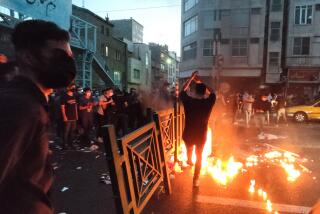Rosebud
- Share via
In 1985, the Egyptian novelist Naguib Mahfouz published a book titled “The Day the Leader Was Murdered.” Mahfouz was widely known as a supporter of “The Leader,” Egyptian President Anwar Sadat, who had been assassinated four years earlier for making peace with Israel in the form of the historic Camp David treaty. Sadat, who began his term of office with a brilliant surprise attack on Israel over the Yom Kippur holy days in 1973, made a stunning volte face in 1977 with the first state visit of any Arab leader to Israel and shared the Nobel Peace Prize that year with Israeli President Menachem Begin. A hero to some, a traitor to others, an idealist and a politician, a man of compassion and a brute, Sadat became increasingly enigmatic. His assassination elicited none of the popular grief that greeted the death of his predecessor, Gamel Abdul Nasser.
In 1985, Mahfouz wrote another short book, a novel, which is just now being published in the United States. “Akhenaten: Dweller in Truth” tells the story of another Egyptian leader, a pharaoh of the 14th century BC. Credited by some as the first monotheist, Akhenaten ruled Egypt a generation before Moses brought the Ten Commandments down from the same Mt. Sinai that Sadat reclaimed 34 centuries later. Published in Egypt three years before Mahfouz won a Nobel Prize (for literature), “Akhenaten” is as much an investigation into the nature of heroes as it is an inquiry into the nature of history.
“It all began with a glance,” says the novel’s young narrator, who serves as our pilot to the mysteries, “a glance that grew into desire, as the ship pushed its way against the calm, strong current at the end of the flood season. The journey started from our city Sais, heading south toward Panopolis, where my sister had lived since her marriage. One late afternoon, our ship passed a strange city. It was bordered by the Nile to the west, and an imposing mountain to the east. Its buildings hinted of a past grandeur that had given way to a haunting evanescence. The roads were empty, the trees were leafless, the gates and windows closed like eyelids of the dead. A city devoid of life, inert, possessed by silence, shadowed by gloom and the spirit of death.”
Shaken by this sight, the young man runs to his father and asks him what happened to the strange city. “Meriamun,” the father replies, “this is the city of the heretic. The cursed and infidel city.” What words could possibly excite the curiosity more?
Like a cub reporter on the scent of the meaning behind the last words of Charles Foster Kane, Meriamun steps off his father’s boat in search of the true history of the heretic. For even though Akhenaten himself is dead, many who knew him are still alive, among them his solitary widow, Nefertiti.
The quest begins. In a series of interviews, Meriamun begins to paint a pictograph of the mysterious Akhenaten. Some call him effeminate and weak; some call him beautiful. All agree that he had an attraction and a power that induced people to follow him, as he ceased worshiping the god Amun of the primary priests and moved to the sun god, Aten.
When he finally relinquished the sun after a midnight vision of the one invisible god, Akhenaten’s belief that love could conquer evil drew converts from among the poor and neglected, and even enlisted the devotion of enemies from beyond the borders of Egypt.
But the rich and powerful were also among those converts, including the High Priest of Amun, Ay, father of Nefertiti, and the captains of both the army and the bodyguards. One of Akhenaten’s few critics is Tadukhipa, the young and beautiful final wife of his father, Amenhotep III. Ignored by the pharaoh, who is as monogamous as he is monotheistic, she tells Meriamun: “Some people thought the problem was that Akhenaten was a noble poet misplaced on the throne by a twist of fate. But the truth is that he was a strange creature, neither man nor woman, driven by shame and stigma to destroy himself and the country.”
Yet the sculptor Bek, Akhenaten’s boyhood friend, defended his prince, calling him a man who knew no evil. In return, Bek was granted the honor of building a new city, Akhetaten, dedicated to the one God, destined to become a deserted shell along the banks of the Nile.
According to the witnesses, the laxity of a religion based on love, combined with the discontent of the priests of Amun and Aten, proved a fatal mixture. Akhenaten’s most loyal followers, from his mother to his childhood friend and body guard, finally deserted him and his new city, returning to Thebes to crown his younger brother Tutankhamun as pharaoh of Egypt.
Even the beautiful Nefertiti, reviled by some as a whore and praised by others as a woman of infinite spirituality, left Akhenaten shortly before his mysterious death to retreat to a palace in the northern quarter of the city.
It is there that Meriamun finds this last inhabitant of Akhetaten, in “the middle of autumn and the Nile was still in flood. Its mud-red water had filled the palace lake. . . . ‘You must have heard a lot of tales about Akhenaten and me,’ she said. ‘Now you can hear the whole truth.’ ”
*
Yet although Meriamun comes away from this final interview with Nefertiti converted, he is no closer to the truth, perhaps, than the reporter at San Simeon who missed the burning sled.
The 88-year-old Mahfouz has wandered the alleys of fiction and journalism searching for a variety of truths over his long career. The Dickensian truths of cafes and characters are perhaps best known to Western readers of his “Cairo Trilogy.” But Mahfouz’s greatest book may, in fact, be another novel that searches for spiritual and philosophical truths, dealing in parables and faith. His 1959 “Children of Gebelaawi,” which portrays average Egyptians as living the lives of Cain and Abel, Moses, Jesus and Muhammad, reports truths so dangerous that it remains unpublished in Egypt and is considered the cause of an attempt on the author’s life in 1995.
“Son of two civilizations,” Pharaonic and Islamic, Mahfouz described himself in his Nobel speech, and it is often difficult to determine which Mahfouz is telling which story.
“In one victorious battle against Byzantium,” Mahfouz says of his Islamic heritage, “it gave back its prisoners of war in return for a number of books of the ancient Greek heritage in philosophy, medicine and mathematics. This is a testimony of value for the human spirit in its demand for knowledge, even though the demander was a believer in God and what was demanded was the fruit of a pagan civilization.” Books for peace: What nobler trade could be made by the chronicler of Sadat and Akhenaten? *
More to Read
Sign up for our Book Club newsletter
Get the latest news, events and more from the Los Angeles Times Book Club, and help us get L.A. reading and talking.
You may occasionally receive promotional content from the Los Angeles Times.








